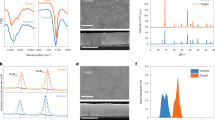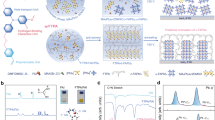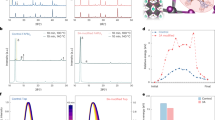Abstract
Formamidinium-rich triiodide perovskites show great promise as light-absorption layers for next photovoltaic technology. However, the intricate process of phase transformation during the crystallization of this perovskite typically results in the presence of undesired hexagonal phases, leading to a degradation in solar cell efficiency and stability. Here we report the use of a hydrogen-bonded eutectic molecule (EM) as a [PbI6]4− octahedra ligand to promote the dominant formation of corner-sharing octahedra. Our results demonstrate that the increased ratio of corner-sharing octahedra to face-sharing octahedra can prompt a complete phase transformation and facilitate the formation of pure cubic structure perovskite. Perovskite solar cells based on EM-fabricated films provide a power conversion efficiency of 25.8% (certified 25.7%) and excellent stability with a T95 lifetime of ~2,000 h.
This is a preview of subscription content, access via your institution
Access options
Access Nature and 54 other Nature Portfolio journals
Get Nature+, our best-value online-access subscription
$32.99 / 30 days
cancel any time
Subscribe to this journal
Receive 12 print issues and online access
$259.00 per year
only $21.58 per issue
Buy this article
- Purchase on SpringerLink
- Instant access to full article PDF
Prices may be subject to local taxes which are calculated during checkout




Similar content being viewed by others

Data availability
All data are available in the main text or the Supplementary Information. Additional information can be obtained from corresponding authors upon reasonable request.
References
Kim, J. Y., Lee, J.-W., Jung, H. S., Shin, H. & Park, N.-G. High-efficiency perovskite solar cells. Chem. Rev. 120, 7867–7918 (2020).
Azmi, R. et al. Damp heat-stable perovskite solar cells with tailored-dimensionality 2D/3D heterojunctions. Science 376, 73–77 (2022).
Chen, H. et al. Quantum-size-tuned heterostructures enable efficient and stable inverted perovskite solar cells. Nat. Photon. 16, 352–358 (2022).
Li, G. et al. Highly efficient p-i-n perovskite solar cells that endure temperature variations. Science 379, 399–403 (2023).
Al-Ashouri, A. et al. Monolithic perovskite/silicon tandem solar cell with >29% efficiency by enhanced hole extraction. Science 370, 1300–1309 (2020).
Saliba, M. et al. Cesium-containing triple cation perovskite solar cells: improved stability, reproducibility and high efficiency. Energy Environ. Sci. 9, 1989–1997 (2016).
Mariotti, S. et al. Interface engineering for high-performance, triple-halide perovskite-silicon tandem solar cells. Science 381, 63–69 (2023).
Huang, Y., Lei, X., He, T., Jiang, Y. & Yuan, M. Recent progress on formamidinium-dominated perovskite photovoltaics. Adv. Energy Mater. 12, 2100690 (2022).
Hui, W. et al. Stabilizing black-phase formamidinium perovskite formation at room temperature and high humidity. Science 371, 1359–1364 (2021).
Shi, P. et al. Oriented nucleation in formamidinium perovskite for photovoltaics. Nature 620, 323–327 (2023).
Bisconti, F. et al. Blocking wide bandgap mixed halide perovskites’ decomposition through polymer inclusion. J. Mater. Chem. C 11, 12213–12221 (2023).
Bravetti, G. et al. Solution aging promotes the formation of hexagonal polytypes in mixed-cation/-halide perovskites. Chem. Mater. 36, 3150–3163 (2024).
Macpherson, S. et al. Local nanoscale phase impurities are degradation sites in halide perovskites. Nature 607, 294–300 (2022).
Doherty, T. A. S. et al. Performance-limiting nanoscale trap clusters at grain junctions in halide perovskites. Nature 580, 360–366 (2020).
Nan, Z.-A. et al. Revealing phase evolution mechanism for stabilizing formamidinium-based lead halide perovskites by a key intermediate phase. Chem 7, 2513–2526 (2021).
Zhang, W. & Zhou, H. Perovskite intermediate phases fundamentally address the urgent stability issue. Chem 7, 2862–2865 (2021).
Wang, R. et al. Caffeine improves the performance and thermal stability of perovskite solar cells. Joule 3, 1464–1477 (2019).
Kim, H., Lee, J. W., Han, G. R., Kim, S. K. & Oh, J. H. Synergistic effects of cation and anion in an ionic imidazolium tetrafluoroborate additive for improving the efficiency and stability of half-mixed Pb-Sn perovskite solar cells. Adv. Funct. Mater. 31, 2008801 (2020).
Zhang, Y. et al. A strategy to produce high efficiency, high stability perovskite solar cells using functionalized ionic liquid‐dopants. Adv. Mater. 29, 1702157 (2017).
Lin, Y.-H. et al. A piperidinium salt stabilizes efficient metal-halide perovskite solar cells. Science 369, 96–102 (2020).
Bai, S. et al. Planar perovskite solar cells with long-term stability using ionic liquid additives. Nature 571, 245–250 (2019).
Li, F. et al. Hydrogen-bond-bridged intermediate for perovskite solar cells with enhanced efficiency and stability. Nat. Photon. 17, 478–484 (2023).
Kim, M. et al. Methylammonium chloride induces intermediate phase stabilization for efficient perovskite solar cells. Joule 3, 2179–2192 (2019).
Hansen, B. B. et al. Deep eutectic solvents: a review of fundamentals and applications. Chem. Rev. 121, 1232–1285 (2021).
Hammond, O. S., Bowron, D. T. & Edler, K. J. Liquid structure of the choline chloride-urea deep eutectic solvent (reline) from neutron diffraction and atomistic modeling. Green Chem. 18, 2736–2744 (2016).
Yuan, C. et al. Temperature- and pressure-induced phase transitions of choline chloride-urea deep eutectic solvent. J. Mol. Liq. 291, 111343 (2019).
Smith, E. L., Abbott, A. P. & Ryder, K. S. Deep eutectic solvents (DESs) and their applications. Chem. Rev. 114, 11060–11082 (2014).
Ashworth, C. R., Matthews, R. P., Welton, T. & Hunt, P. A. Doubly ionic hydrogen bond interactions within the choline chloride-urea deep eutectic solvent. Phys. Chem. Chem. Phys. 18, 18145–18160 (2016).
Zhang, J. et al. 1D choline-PbI3-based heterostructure boosts efficiency and stability of CsPbI3 perovskite solar cells. Angew. Chem. Int. Ed. 62, e202303486 (2023).
McMeekin, D. P. et al. Intermediate-phase engineering via dimethylammonium cation additive for stable perovskite solar cells. Nat. Mater. 22, 73–83 (2023).
Fiuza-Maneiro, N. et al. Ligand chemistry of inorganic lead halide perovskite nanocrystals. ACS Energy Lett. 8, 1152–1191 (2023).
Udayabhaskararao, T. et al. A mechanistic study of phase transformation in perovskite nanocrystals driven by ligand passivation. Chem. Mater. 30, 84–93 (2018).
Wang, S., Du, L., Jin, Z., Xin, Y. & Mattoussi, H. Enhanced stabilization and easy phase transfer of CsPbBr3 perovskite quantum dots promoted by high-affinity polyzwitterionic ligands. J. Am. Chem. Soc. 142, 12669–12680 (2020).
Snaith, H. J. et al. Anomalous hysteresis in perovskite solar cells. J. Phys. Chem. Lett. 5, 1511–1515 (2014).
Acknowledgements
W.C.H.C. thanks the project of the University Grant Council of the University of Hong Kong (grant number 202011159254), General Research Fund (grant numbers 17211220, 17200021 and 17200823), Collaborative Research (grant number C5037-18G) from the Research Grants Council of Hong Kong Special Administrative Region, China, and Innovation and Technology Fund (grant numbers MRP/040/21X and GHP/245/22SZ) from Innovation and Technology Commission of Hong Kong Special Administrative Region, China. Y.W. thanks the National Science Fund for Excellent Young Scholars (Overseas), Top Talent Project of West Lake Pearl Project, National Natural Science Foundation of China (grant number 52302315), National Natural Science Foundation of China (grant numbers 52302315 and 62474157) and the talent project of ZJU-Hangzhou Global Scientific and Technological Innovation Center (grant number 02170000-K02013017). B.X. thanks the National Key Research and Development Project funding from the Ministry of Science and Technology of China (grant number 2021YFB3800101), National Natural Science Foundation of China (grant number U19A2089), Guangdong-Hong Kong-Macao Joint Laboratory (grant number 2019B121205001), and Key Fundamental Research Project funding from the Shenzhen Science and Technology Innovation Committee (grant number JCYJ20220818100406014). G.Z. thanks the Shanghai Sailing Program (grant number 21YF1453500), National Natural Science Foundation of China (grant number 12104467) and Youth Innovation Promotion Association of the Chinese Academy of Sciences (grant number 2023305).
Author information
Authors and Affiliations
Contributions
Z.-W.G., W.C.H.C., B.X. and Y.W. conceived the idea. W.C.H.C. coordinated the work. Y.W., B.X. and W.C.H.C. supported this work. Z.-W.G. fabricated and characterized the devices. J.Z. and J.S. carried out the TAS and PL experiments. G.Z., Y.T. and X.L. contributed to the GIWAXS test and analysis. Z.-W.G., H.S., D.W., J.F. and L.Q. contributed to data analysis. Z.-W.G. wrote the original draft and W.C.H.C., H.S., B.X. and Y.W. reviewed and edited the draft.
Corresponding authors
Ethics declarations
Competing interests
The authors declare no competing interests.
Peer review
Peer review information
Nature Photonics thanks Gianluca Bravetti and the other, anonymous, reviewer(s) for their contribution to the peer review of this work.
Additional information
Publisher’s note Springer Nature remains neutral with regard to jurisdictional claims in published maps and institutional affiliations.
Supplementary information
Supplementary Information
Supplementary Figs. 1–29 and Tables 1–3.
Rights and permissions
Springer Nature or its licensor (e.g. a society or other partner) holds exclusive rights to this article under a publishing agreement with the author(s) or other rightsholder(s); author self-archiving of the accepted manuscript version of this article is solely governed by the terms of such publishing agreement and applicable law.
About this article
Cite this article
Gao, ZW., Wang, D., Fang, J. et al. Eutectic molecule ligand stabilizes photoactive black phase perovskite. Nat. Photon. 19, 258–263 (2025). https://doi.org/10.1038/s41566-024-01596-8
Received:
Accepted:
Published:
Issue date:
DOI: https://doi.org/10.1038/s41566-024-01596-8


